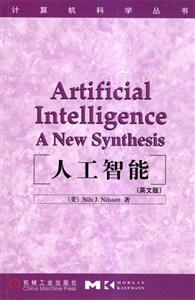包郵 人工智能:英文
計(jì)算機(jī)科學(xué)叢書(shū)
有劃線(xiàn)標(biāo)記、光盤(pán)等附件不全詳細(xì)品相說(shuō)明>>
-
>
全國(guó)計(jì)算機(jī)等級(jí)考試最新真考題庫(kù)模擬考場(chǎng)及詳解·二級(jí)MSOffice高級(jí)應(yīng)用
-
>
決戰(zhàn)行測(cè)5000題(言語(yǔ)理解與表達(dá))
-
>
軟件性能測(cè)試.分析與調(diào)優(yōu)實(shí)踐之路
-
>
第一行代碼Android
-
>
JAVA持續(xù)交付
-
>
EXCEL最強(qiáng)教科書(shū)(完全版)(全彩印刷)
-
>
深度學(xué)習(xí)
人工智能:英文 版權(quán)信息
- ISBN:7111074386
- 條形碼:9787111074380 ; 978-7-111-07438-0
- 裝幀:簡(jiǎn)裝本
- 冊(cè)數(shù):暫無(wú)
- 重量:暫無(wú)
- 所屬分類(lèi):>
人工智能:英文 內(nèi)容簡(jiǎn)介
本書(shū)介紹了人工智能領(lǐng)域中*重要的一個(gè)概念——智能代理。本書(shū)從*基本的反應(yīng)式代理入手,逐步向人們展示了現(xiàn)代人工智能不斷增強(qiáng)的認(rèn)知能力,同時(shí)也例證了該領(lǐng)域中重要且經(jīng)久不衰的思維、思想。神經(jīng)網(wǎng)絡(luò)、遺傳程序設(shè)計(jì)、計(jì)算機(jī)視覺(jué)、探視搜索、知識(shí)表示和推理、貝葉斯網(wǎng)絡(luò)、規(guī)劃和語(yǔ)言理解等有關(guān)人工智能的重要內(nèi)容都通過(guò)本書(shū)所描述的各種代理的不斷增長(zhǎng)的能力得以展現(xiàn)。本書(shū)作者是人工智能領(lǐng)域的主要開(kāi)創(chuàng)者和重要帶頭人,正是他提供給了廣大讀者一個(gè)耳目一新和富有生機(jī)的合成技術(shù),該技術(shù)將領(lǐng)導(dǎo)人類(lèi)把整個(gè)人工智能領(lǐng)域的研究引向一個(gè)新的境界。 Nils J. Nilsson: Artificial Intelligence, A New Synthesis. Copyright @ 1998 by Morgan Kaufmann Publishers, Inc. Harcourt Asia Pte Ltd under special arrangement with Morgan Kaufmann authorizes China Machine Press to print and exclusively distribute this edition, which is the only authorized complete and unabridged reproduction of the latest American Edition published and priced for sale in China only, not including Hong Kong SAR and Taiwan. Unauthorized export of this edition is a violation of the Copyright Act. Violation of this Law is subjected to Civil and Criminal penalties.
人工智能:英文 目錄
1 Introduction
1.1 What is AI?
1.2 Approaches to Artificial Intelligence
1.3 Brief History of AI
1.4 Plan of the Book
1.5 Additional Readings and Discussion
I Reactive Machines
2 Stimulus-Response Agents
2.1 Perception and Action
2.2 Representing and Implementing Action Functions
2.3 Additional Readings and Discussion
3 Neural Networks
3.1 Introduction
3.2 Training Single TLUs
3.3 Neural Networks
3.4 Generalization, Accuracy, and Overfitting
3.5 Additional Readings and Discussion
4 Machine Evolution
4.1 Evolutionary Computation
4.2 Genetic Programming
4.3 Additional Readings and Discussion
5 State Machines
5.1 Representing the Environment by Feature Vectors
5.2 Elman Networks
5.3 Iconic Representations
5.4 Blackboard Systems
5.5 Additional Readings and Discussion
6 Robot Vision
6.1 Introduction
6.2 Steering a Van
6.3 Two Stages of Robot Vision
6.4 Image Processing
6.5 Scene Analysis
6.6 Stereo Vision
6.7 Additional Readings and Discussion
II Search in State Spaces
7 Agents that Plan
7.1 Memory Versus Computation
7.2 State-Space Graphs
7.3 Searching Explicit State Spaces
7.4 Feature-Based State Spaces
7.5 Graph Notation 7.6 Additional Readings and Discussion
8 Uninformed Search
8.1 Formulating the State Space
8.2 Components of Implicit State-Space Graphs
8.3 Breadth-First Search
8.4 Depth-First or Bracktracking Search
8.5 Iterative Deepening
8.6 Additional Readings and Discussion
9 Heuristic Search
9.1 Using Evaluation Functions
9.2 A General Graph-Searching Algorithm
9.3 Heuristic Functions and Search Efficiency
9.4 Additional Readings and Discussion
10 Planning, Acting, and Learning
10.1 The Sense/Plan/Act Cycle
10.2 Approximate Search
10.3 Learning Heuristic Functions
10.4 Rewards Instead of Goals
10.5 Additional Readings and Discussion
11 Alternative Search Formulations and Applications
11.1 Assignment Problems
11.2 Constructive Methods
11.3 Heuristic Repair
11.4 Function Optimization
12 Adversarial Search
12.1 Two-Agent Games
12.2 The Minimax Procedure
12.3 The Alpha-Beta Procedure
12.4 The Search Efficiency of the Alpha-Beta Procedure
12.5 Other Important Matters
12.6 Games of Chance
12.7 Learning Evaluation Functions
12.8 Additional Readings and Discussion
III Knowledge Representation and Reasoning
13 The Propositional Calculus
13.1 Using Constraints on Feature Values
13.2 The Language
13.3 Rules of Inference
13.4 Definition of Proof
13.5 Semantics
13.6 Soundness and Completeness
13.7 The PSAT Problem
13.8 Other Important Topics
14 Resolution in The Propositional Calculus
14.1 A New Rule of Inference: Resolution
14.2 Converting Arbitrary wffs to Conjunctions of Clauses
14.3 Resolution Refutations
14.4 Resolution Refutation Search Strategies
14.5 Horn Clauses
15 The Predicate Calculus
15.1 Motivation
15.2 The Language and its Syntax
15.3 Semantics
15.4 Quantification
15.5 Semantics of Quantifiers
15.6 Predicate Calculus as a Language for Representing Knowledge
15.7 Additional Readings and Discussion
16 Resolution in the Predicate Calculus
16.1 Unification
16.2 Predicate-Calculus Resolution
16.3 Completeness and Soundness
16.4 Converting Arbitrary wffs to Clause Form
16.5 Using Resolution to Prove Theorems
16.6 Answer Extraction
16.7 The Equality Predicate
16.8 Additional Readings and Discussion
17 Knowledge-Based Systems
17.1 Confronting the Real World
17.2 Reasoning Using Horn Clauses
17.3 Maintenance in Dynamic Knowledge Bases
17.4 Rule-Based Expert Systems
17.5 Rule Learning
17.6 Additional Readings and Discussion
18 Representing Commonsense Knowledge
18.1 The Commonsense World
18.2 Time
18.3 Knowledge Representation by Networks
18.4 Additional Readings and Discussion
19 Reasoning with Uncertain Information
19.1 Review of Probability Theory
19.2 Probabilistic Inference
19.3 Bayes Networks
19.4 Patterns of Inference in Bayes Networks
19.5 Uncertain Evidence
19.6 D-Seperation
19.7 Probabilistic Inference in Polytrees
19.8 Additional Readings and Discussion
20 Learning and Acting with Bayes Nets
20.1 Learning Bayes Nets
20.2 Probabilistic Inference and Action
20.3 Additional Readings and Discussion
IV Planning Method Based on Logic
21 The Situation Calculus
21.1 Reasoning about States and Actions
21.2 Some Difficulties
21.3 Generating Plans
21.4 Additional Reading and Discussion
22 Planning
22.1 STRIPS Planning Systems
22.2 Plan Spaces and Partial-Order Planning
22.3 Hierarchical Planning
22.4 Learning Plans'
22.5 Additional Readings and Discussion
V Communication and Integration
23 Multiple Agents
23.1 Interacting Agents
23.2 Models of Other Agents
23.3 A Modal Logic of Knowledge
23.4 Additional Readings and Discussion
24 Communication Among Agents
24.1 Speech Acts
24.2 Understanding Language Strings
24.3 Efficient Communication
24.4 Natural Language Processing
24.5 Additional Readings and Discussion
25 Agent Architectures
25.1 Three-Level Architectures
25.2 Goal Arbitration
25.3 The Triple-Tower Architecture
25.4 Bootstrapping
25.5 Additional Readings and Discussion
- >
企鵝口袋書(shū)系列·偉大的思想20:論自然選擇(英漢雙語(yǔ))
- >
新文學(xué)天穹兩巨星--魯迅與胡適/紅燭學(xué)術(shù)叢書(shū)(紅燭學(xué)術(shù)叢書(shū))
- >
名家?guī)阕x魯迅:朝花夕拾
- >
詩(shī)經(jīng)-先民的歌唱
- >
山海經(jīng)
- >
自卑與超越
- >
苦雨齋序跋文-周作人自編集
- >
朝聞道















